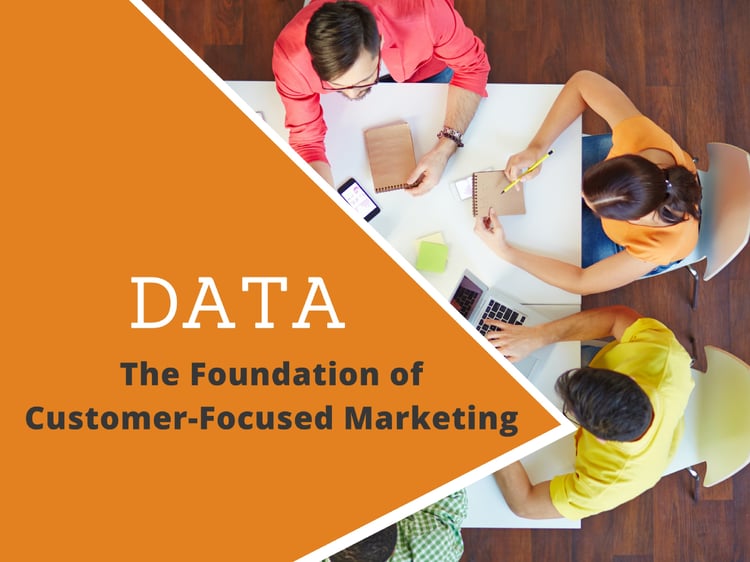In the ever-changing data privacy landscape, several laws are set to take effect in 2023 which contain a number of new requirements. We've created a checklist to help...

All companies say they care about their customers. But caring about your customers only goes so far if that statement isn’t accompanied by actionable insights regarding the preferences and habits of those customers, and a business model that places the customer at the center of your organization. The responsible and efficient use of data is essential when building a customer-focused organization. While knowledge is indeed power, it’s not enough to simply collect reams of data. Knowing exactly what to do with that data is how businesses can win in this era of personalization and enhanced customer experience.
A View of Your Customers
It’s important for CMOs to have a holistic view of their customers. In other words, simply looking at sales figures and response analysis doesn’t really tell a CMO much about the company or its success. An excellent CMO always strives to connect the dots between sales and the life situations of their customers. This isn’t done for the sole purpose of driving revenue. Instead, this approach is necessary to better understand the true supporters of your company. The more a company knows about its customers, the better it’s able to market to that audience on an individual basis.
CMOs must always grasp the context that lies beneath any consumer trend. For example, a sudden surge in the amount of crayons sold by a retailer right before the start of a school year might be misinterpreted without the context that goes along with that change. Imagine the thought process of a CMO that simply saw his or her crayon sales increase without factoring in the back-to-school component. Without that information, a CMO might assume that crayons are becoming increasingly more popular, or they may figure that people prioritize the arts and crafts items sold by that retailer. Either assumption could be disastrous for a retailer that jumps the gun. Most real life situations are significantly more nuanced than this example, but those nuances can be accurately interpreted with the right data.
In today’s world, the timeframe for connecting the dots between consumer behavior and the world around them is rapidly decreasing. A celebrity tweet about a given product can cause sales of that item to skyrocket. Businesses must be ready to tie these two factors together so that they can accurately assess the impact of the tweet. However, this is much easier said than done.
According to Forrester, less than 30 percent of companies who have a stated desire to operate with a data-driven customer understanding are actually effective in terms of connecting consumer behavior to the numbers beneath those actions. Modern analytics make it easier than ever to make these connections, but putting the customer at the heart of your organization requires the correct infrastructure and consumer-facing perspective for mining data and turning those findings into actionable responses.
The Scope of Data
One of the best things about using data while building a customer-focused organization is that companies have the unique opportunity to learn a lot about themselves as well as their consumers. It’s entirely possible for businesses to have glaring flaws in their internal processes — or in their marketing — that are completely unnoticed. The systems put in place by customer-focused marketing help to illuminate those areas so that companies can address their shortcomings.
This power isn’t limited to issues that exist under the company’s roof. In fact, this approach is highly effective for any company that wants to truly understand its niche and make sure that it’s meeting the needs of its customers. This is one of those areas where it’s very important for companies to know they’re speaking the language of their consumers; however, there’s a decent possibility that the company might be missing the mark in at least one area.
Consider the case of a company that allows consumers to build their own computers. On one hand, the company has its own niche, and it considers itself to be an industry leader for allowing customization to this degree. However, the data shows that consumers are actually intimidated by all of these choices that they don’t truly understand, and that they’d rather just buy a ready-made computer. This is a connection that would never be made without the careful collection and analysis of data, which provides the company with a deeper understanding of what their audience really wants and needs from them. It’s an insight that could save the company. This data allows the company’s executives to make an informed choice, which includes some level of assurance if the company chooses to go in the direction that the data suggests is correct.
Collecting and analyzing data is a great way for companies to make sure they’re on the same page with their customers. That is, it helps ensure that consumers are asking for what the company makes and that those consumers are adequately responding to the company’s message. On the other side of the equation, businesses can make sure they’re targeting the right niches, and if they find that they aren’t, those companies have a chance to re-evaluate their strategy. In any instance, the data will reveal whether or not a business’s messages hit home with audiences; more importantly, data empowers marketers with the insights they need to learn what customers find most valuable, and then deliver on that knowledge.
Data Is Not Omniscient
We’ve talked a lot about the power of data, and indeed it has the potential to yield positive changes and ignite customer-focused marketing for any company that takes its data seriously. However, it’s important to remember the things that data can’t do.
Data is only as good as the actionable and effective insights derived from the numbers. This means that using data the wrong way doesn’t help anyone – which in the end affects the consumer. In fact, because of the time and resources involved in utilizing that data, doing data wrong can make a company’s desire to meet customer expectations much more challenging.
Take personalization, for instance. It’s all the rage, and with good reason — it’s been proven that people are willing to pay more for a personalized marketing experience that appeals directly to them. The problem is when companies take personalization too far, which can happen in even the most experienced organizations. There’s a fine line between personalization and creepiness, and you might cross that line without even realizing it. Possessing the phone number of a customer doesn’t give you the right to bombard them with phone calls and text messages.
Data is a tremendous tool for guiding your actions and providing insights into what makes your audience tick. Data, by itself, is not a basis for doing anything that’s related to marketing. To use data effectively across your organization, you need data and personnel that know exactly how to utilize that data to its fullest potential. This makes sense not only from a practicality standpoint, but it’s also a helpful reminder to consider things from the customer’s perspective. Nobody buys solely on price anymore. Consumers do research, they ask around, they read reviews. And just as your audience does their homework on your company, so too should you conduct a reality check and make sure your numbers are accompanied by customer-focused, actionable marketing.
Create a Solid Foundation for Your Customer-Focused Organization
Building a customer-focused organization doesn’t just happen because you like the idea of caring about your customers. Recording and properly applying data to your marketing strategies is vital in order to truly put the customer first. Constantly striving to understand the motivations and actions of your audience will help you to know your customers better, while data’s hidden applications can help you to correct problems you never knew existed. By using data correctly — and by avoiding the pitfalls that come with failing to do so — you’ll be well on your way towards creating a well-oiled marketing machine your audience will love.

